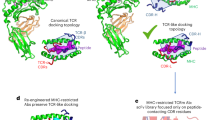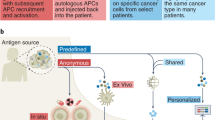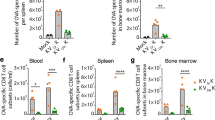Abstract
Tumor-associated carbohydrate (TAC) antigens are important targets in cancer vaccine efforts. Carbohydrates are, however, frequently poor immunogens, in that they are T-cell–independent antigens. Molecular mimicry of TAC by peptides is an alternative approach to generating anti-carbohydrate immune responses. Here we demonstrate that peptide mimotopes can elicit antibody responses that cross-react with representative human TAC antigens. Primary immunization with such a multiple antigenic peptide, along with QS-21 as adjuvant, elicits cytotoxic antibodies reactive with naturally occurring forms of TAC expressed on tumor cells, and vaccination of mice with peptide mimotopes reduced tumor growth and prolonged host survival in a murine tumor model.
This is a preview of subscription content, access via your institution
Access options
Subscribe to this journal
Receive 12 print issues and online access
$209.00 per year
only $17.42 per issue
Buy this article
- Purchase on Springer Link
- Instant access to full article PDF
Prices may be subject to local taxes which are calculated during checkout




Similar content being viewed by others
References
Hakomori, S. Aberrant glycosylation in tumors and tumor-associated carbohydrate antigens. Adv. Cancer Rres. 52, 257– 331 (1989).
Livingston, P.O. & Ragupathi, G. Carbohydrate vaccines that induce antibodies against cancer. 2. Previous experience and future plans. Cancer Immunol. Immunother. 45, 10–19 (1997).
Mond, J.J., Lees, A. & Snapper, C.M. T cell-independent antigens type 2. [Review]. Annu. Rev. Immunol. 13, 655–692 (1995).
Livingston, P.O., Zhang, S. & Lloyd, K.O. Carbohydrate vaccines that induce antibodies against cancer. 1. Rationale. Cancer Immunol., Immunother. 45, 1–9 (1997).
Chapman, P.B. Anti-idiotypic monoclonal antibody cancer vaccines. Semin. Cancer Biol. 6, 367–374 ( 1995).
Hoess, R., Brinkmann, U., Handel, T. & Pastan, I. Identification of a peptide which binds to the carbohydrate-specific monoclonal antibody B3. Gene 128, 43– 49 (1993).
Luo, P. et al. Antigenic and immunological mimicry of peptide mimotopes of adenocarcinoma associated carbohydrate antigens. Mol. Immunol. 13, 865–879 (1998).
Qiu, J., Luo, P., Wasmund, K., Steplewski, Z. & Kieber-Emmons, T. Towards the development of peptide mimotopes of carbohydrate antigens as cancer vaccines. Hybridoma 18, 103–112 (1999).
Taki, T., Ishikawa, D., Hamasaki, H. & Handa, S. Preparation of peptides which mimic glycosphingolipids by using phage peptide library and their modulation on beta-galactosidase activity. FEBS Lett. 418, 219–223 ( 1997).
Oldenburg, K.R., Loganathan, D., Goldstein, I.J., Schultz, P.G. & Gallop, M.A. Peptide ligands for a sugar-binding protein isolated from a random peptide library. Proc. Natl. Acad. Sci. USA 89, 5393–5397 ( 1992).
Scott, J.K., Loganathan, D., Easley, R.B., Gong, X. & Goldstein, I.J. A family of concanavalin A-binding peptides from a hexapeptide epitope library. Proc. Natl. Acad. Sci. USA 89, 5398–5402 ( 1992).
Murai, H. et al. Amino acid sequence of protein alpha-amylase inhibitor from Streptomyces griseosporeus YM-25. J. Biochem. 97 , 1129–1133 (1985).
Westerink, M.A.J., Giardina, P.C., Apicella, M.A. & Kieber-Emmons, T. Peptide mimicry of the meningococcal group C capsular polysaccharide. Proc. Natl. Acad. Sci. USA 92, 4021– 4025 (1995).
Imberty, A. et al. Computer simulation of histo-blood group oligosaccharides: energy maps of all constituting disaccharides and potential energy surfaces of 14 ABH and Lewis carbohydrate antigens. Glycoconjugate J. 12, 331–349 (1995).
Agadjanyan, M. et al. Peptide mimicry of carbohydrate epitopes on human immunodeficiency virus. Nat. Biotechnol. 15, 547– 551 (1997).
Fehr, T. et al. Role of repetitive antigen patterns for induction of antibodies against antibodies. J. Exp. Med. 185, 1785 –1792 (1997).
Zhang, S. et al. Immune sera and monoclonal antibodies define two configurations for the sialyl Tn tumor antigen. Cancer Res. 55, 3364–3368 (1995).
Kudryashov, V. et al. Immunogenicity of synthetic conjugates of Lewis(y) oligosaccharide with proteins in mice: towards the design of anticancer vaccines. Cancer Immunol. Immunother. 45, 281– 286 (1998).
Steplewski, Z. et al. Tumor cell lysis and tumor growth inhibition by the isotype variants of MAb BR55-2 directed against Y oligosaccharide. In Vivo 5, 79–83 (1991 ).
Noguchi, Y., Richards, E.C., Chen, Y.T. & Old, L.J. Influence of interleukin 12 on p53 peptide vaccination against established Meth A sarcoma. Proc. Natl. Acad. Sci..USA 92, 2219–2223 (1995).
Jiao, Y. & Fujimoto, S. Sequential T cell response involved in tumor rejection of sarcoma, Meth A, in syngeneic mice. Jpn. J. Cancer Res. 89, 657–665 (1998).
Tsuyuoka, K. et al. Characterization of a T-cell line specific to an anti-Id antibody related to the carbohydrate antigen, sialyl ssea-1, and the immunodominant T-cell antigenic site of the antibody. J. Immunol. 157, 661–669 (1996).
Helling, F. et al. GM2-KLH conjugate vaccine: increased immunogenicity in melanoma patients after administration with immunological adjuvant QS-21. Cancer Res. 55, 2783–2788 (1995).
Kitamura, K. et al. Serological response patterns of melanoma patients immunized with a GM2 ganglioside conjugate vaccine. Proc. Natl. Acad. Sci. USA 92, 2805–2809 ( 1995).
Longenecker, B.M., Reddish, M., Koganty, R. & MacLean, G.D. Specificity of the IgG response in mice and human breast cancer patients following immunization against synthetic sialyl-Tn, an epitope with possible functional significance in metastasis. Adv. Exp. Med. Biol. 353, 105–124 (1994).
Jones, R.C. et al. Immune response to polyvalent melanoma cell vaccine in AJCC stage III melanoma: an immunologic survival model. Ann. Surg. Oncol. 3, 437–445 ( 1996).
Pantel, K. et al. Frequency and prognostic significance of isolated tumour cells in bone marrow of patients with non-small-cell lung cancer without overt metastases. Lancet 347, 649–653 (1996).
Houghton, A.N. & Lloyd, K.O. Stuck in the MUC on the long and winding road. Nat. Med. 4, 270–271 (1998).
Ravindranath, M.H. et al. Ratio of IgG:IgM antibodies to sialyl Lewis(x) and GM3 correlates with tumor growth after immunization with melanoma-cell vaccine with different adjuvants in mice. Int. J. Cancer 75 , 117–124 (1998).
Putterman, C. & Diamond, B. Immunization with a peptide surrogate for double-stranded DNA (dsDNA) induces autoantibody production and renal immunoglobulin deposition. J. Exp. Med. 188, 29–38 (1998).
Frassanito, M.A. et al. Identification of Meth A sarcoma-derived class I major histocompatibility complex-associated peptides recognized by a specific CD8+ cytotoxic T lymphocyte. Cancer Res. 55, 124–128 (1995).
Abdel, M.U. et al. Immunization with glycosylated Kb-binding peptides generates carbohydrate-specific, unrestricted cytotoxic T cells. Eur. J. Immunol. 26, 544–551 ( 1996).
Bohm, C.M. et al. Carbohydrate recognition on MUC1-expressing targets enhances cytotoxicity of a T cell subpopulation. Scand. J. Immunol. 46, 27–34 (1997).
Dabelsteen, E. Cell surface carbohydrates as prognostic markers in human carcinomas. [Review] [141 refs]. J. Pathol. 179, 358– 369 (1996).
Ravindranath, M.H. et al. Endothelial-selectin ligands sialyl Lewis(x) and sialyl Lewis(a) are differentiation antigens immunogenic in human melanoma. Cancer 79, 1686–1697 ( 1997).
Zhang, S. et al. Selection of tumor antigens as targets for immune attack using immunohistochemistry: II. Blood group-related antigens. Int. J. Cancer 73, 50–56 ( 1997).
Livingston, P.O. Approaches to augmenting the immunogenicity of melanoma gangliosides: from whole melanoma cells to ganglioside–KLH conjugate vaccines. [Review]. Immunol. Rev. 145, 147– 166 (1995).
Kitamura, K. et al. Specificity analysis of blood group Lewis-y (Le(y)) antibodies generatedagainst synthetic and natural Le(y) determinants. Proc. Natl. Acad. Sci. USA 91, 12957–12961 (1994).
Adluri, S. et al. Immunogenicity of synthetic TF-KLH (keyhole limpet hemocyanin) and sTn-KLH conjugates in colorectal carcinoma patients. Cancer Immunol. Immunother. 41, 185–192 (1995).
Phalipon, A. et al. Induction of anti-carbohydrate antibodies by phage library-selected peptide mimics. Eur. J. Immunol. 27, 2620 –2625 (1997).
Harris, S.L. et al. Exploring the basis of peptide–carbohydrate crossreactivity: evidence for discrimination by peptides between closely related anti-carbohydrate antibodies. Proc. Natl. Acad. Sci. USA 94, 2454–2459 (1997).
Pincus, S.H., Smith, M.J., Jennings, H.J., Burritt, J.B. & Glee, P.M. Peptides that mimic the group B streptococcal type III capsular polysaccharide antigen. J. Immunol. 160, 293–298 (1998).
Valadon, P., Nussbaum, G., Boyd, L.F., Margulies, D.H. & Scharff, M.D. Peptide libraries define the fine specificity of anti-polysaccharide antibodies to Cryptococcus neoformans. J. Mol. Biol. 261, 11–22 (1996).
Zhang, H., Zhong, Z. & Pirofski, L.A. Peptide epitopes recognized by a human anti-cryptococcal glucuronoxylomannan antibody. Infect. Immun. 65, 1158–1164 (1997).
Ishikawa, D. et al. GD1α-replica peptides functionally mimic GD1α, an adhesion molecule of metastatic tumor cells, and suppress the tumor metastasis. FEBS Lett. 441, 20–24 (1998).
Kundu, N., Beaty, T.L., Jackson, M.J. & Fulton, A.M. Antimetastatic and antitumor activities of interleukin 10 in a murine model of breast cancer. J. Natl. Cancer Inst. 88, 536–541 (1996).
Acknowledgements
This work was supported by the USAMRMC (DAMD17-94-J-4310) Breast Cancer Program (T.K.E.) and NIH grant AI 45133 (T.K.E.). We thank Charlotte Read Kensil of Aquila Pharmaceuticals (Worcester, MA.) for supplying the QS-21. We also thank Dr. A. DeLeo (University of Pittsburgh) for the Meth A cell line and Dr. A Fulton (University of Maryland Cancer Center) for the murine breast lines.
Author information
Authors and Affiliations
Corresponding author
Rights and permissions
About this article
Cite this article
Kieber-Emmons, T., Luo, P., Qiu, J. et al. Vaccination with carbohydrate peptide mimotopes promotes anti-tumor responses . Nat Biotechnol 17, 660–665 (1999). https://doi.org/10.1038/10870
Received:
Accepted:
Issue Date:
DOI: https://doi.org/10.1038/10870
This article is cited by
-
The clinical impact of glycobiology: targeting selectins, Siglecs and mammalian glycans
Nature Reviews Drug Discovery (2021)
-
Expression analysis of carbohydrate antigens in ductal carcinoma in situof the breast by lectin histochemistry
BMC Cancer (2008)
-
Peptides mimicking GD2 ganglioside elicit cellular, humoral and tumor-protective immune responses in mice
Cancer Immunology, Immunotherapy (2008)
-
Bcipep: A database of B-cell epitopes
BMC Genomics (2005)
-
Emerging themes in medicinal glycoscience
Nature Biotechnology (2000)



